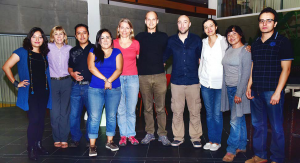
Gennovate: Coding the CRP Global Study on Gender Norms

Patti Petesch, Lone Badstue and Diana López of CIMMYT’s gender unit gave a training workshop at El Batán, Mexico, during 7-17 April on systematic content analysis and coding for the Global Study on Gender Norms, Agency and Innovation in Agriculture and Natural Resource Management, or “Gennovate.” A collaborative initiative of 13 CGIAR research programs, this global qualitative field study will reach approximately 125 villages in 25 countries worldwide, according to Badstue.
“This will provide coders with the knowledge and skills they’ll need to systematically analyze the voices, perspectives and experiences of the women and men from the approximately 70 village case studies that will be conducted by the MAIZE and WHEAT CRPs,” said Badstue.
Also participating was Nadezda Amaya, Regional Gender Research Specialist at the International Potato Center (CIP), who will conduct similar training in Peru as part of Gennovate and of CIP’s participation through the Roots, Tubers and Bananas CRP (RTB).
When asked about the most interesting thing she had learned in the course, Amaya replied “the software itself!” Developed by QSR International, “Nvivo” social science software allows researchers and coders to turn qualitative data, such as oral histories, into standardized quantitative data through coding, allowing cross-regional and CRP comparisons.
Workshop participant Edgar Domínguez agreed with Amaya. “What I like the most is that the software allows us to add value to qualitative data. If you present qualitative data to an economist, for example, you won’t be able to convince her of its value. With a tool like Nvivo software you can present the data numerically, create graphs, statistics, surveys and oral histories, which allows a broader range of people to see the value of your data.”
According to Amaya, the cross-CRP nature of the study is remarkable. “What really stands out in this study is the interaction between various CG centers, and it’s the CRP network that has made this collaboration possible,” she said.
